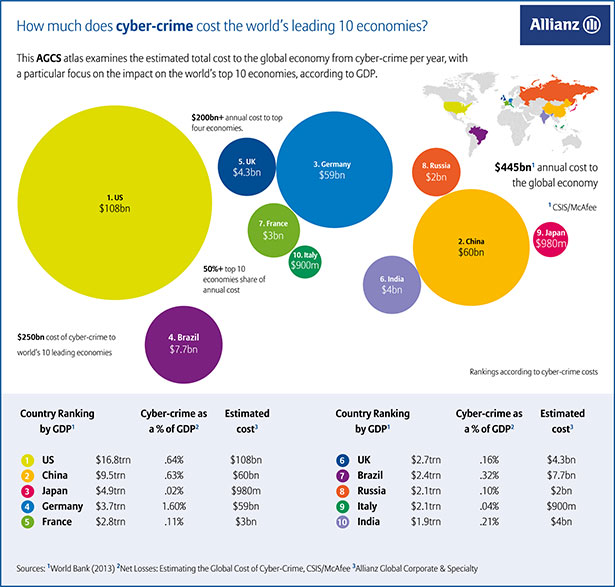“Growth in the US is already underway as data protection regulations help focus minds, while legislative developments and increasing levels of liability will see growth accelerate in the rest of the world,” says Nigel Pearson, who is globally responsible for cyber insurance at AGCS. “There is a general trend towards tougher data protection regimes, backed with the threat of significant fines in the event of a breach.” Hong Kong, Singapore and Australia are among those looking at, or already enforcing, new laws and the European Union is looking to agree pan-European data protection rules. Tougher guidelines on a country-by-country basis can be expected.
Previously, attention has largely been focused on the threat of corporate data breaches and privacy concerns, but the new generation of cyber risk is more complex: future threats will come from intellectual property theft, cyber extortion and the impact of business interruption (BI) following a cyber-attack or from operational or technical failure; a risk which is often underestimated. “Awareness of BI risks and insurance related to cyber and technology is increasing. Within the next five to 10 years BI will be seen as a key risk and a major element of the cyber insurance landscape,” says Georgi Pachov, cyber expert in AGCS’s global property underwriting team. In the context of cyber and IT risks, BI cover can be very broad including business IT computer systems, but also extending to industrial control systems (ICS) used by energy companies or robots used in manufacturing.
Connectivity creates risk
Increasing interconnectivity of everyday devices and growing reliance on technology and real-time data at personal and corporate levels, known as the ‘Internet of Things’, creates further vulnerabilities. Some estimates suggest that a trillion devices could be connected by 2020, while it is also forecast that as many as 50 billion machines could be exchanging data daily. ICS are another area of concern as a number of these still in use today were designed before cyber security became a priority issue. An attack against an ICS could result in physical damage such as fire or explosion, as well as BI.
Catastrophic event
While there have been some very large data breaches, the prospect of a catastrophic loss is becoming more likely, but exactly what it will look like is difficult to predict. Scenarios include a successful attack on the core infrastructure of the internet, a major data breach or anetwork outage for a cloud service provider, while a major cyber-attack involving an energy or utility company could result in significant outage of services, physical damage or even loss of life in future.
Stand-alone cover
Allianz also predicts that the scope of cyber insurance must evolve to provide broader and deeper coverage, addressing business interruption and closing gaps between traditional coverage and cyber policies. While cyber exclusions in property and casualty policies are likely to become commonplace, standalone cyber insurance will continue to evolve as the main source of comprehensive cover. There is growing interest among the telecommunications, retail, energy, utilities and transport sectors, as well as from financial institutions.
Education – both in terms of businesses’ understanding of exposures and underwriting knowledge – must improve if insurers are to meet growing demand. In addition, as with any other emerging risk, insurers also face challenges around pricing, untested policy wordings, modeling and risk accumulation.
Responding to cyber risk
The AGCS report highlights steps companies can take to address cyber risk. Insurance can only be part of the solution, with a comprehensive risk management approach being the foundation for cyber defense. “Once you have purchased cyber insurance, it does not mean that you can ignore IT security. The technological, operational and insurance aspects of risk management go hand in hand,” explains Jens Krickhahn, expert for cyber & fidelity at AGCS Central & Eastern Europe. Cyber risk management is too complex to be the preserve of a single individual or department, so AGCS recommends a ‘think-tank’ approach to tackling risk whereby different stakeholders from across the business collaborate to share knowledge.
In this way, different perspectives can be challenged and alternative scenarios considered: for example, these might include the risks posed by corporate developments such as mergers and acquisitions or by the use of cloud-based or outsourced services. In addition, cross-company involvement is essential to identify key assets at risk and, most importantly, to develop and test robust crisis response plans.

